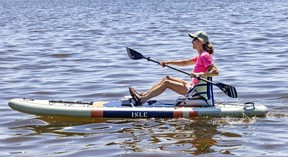Whether you prefer a paddleboard, kayak or canoe, there are plenty of options for paddlers of all ages and abilities.
Article content
Postmedia may earn an affiliate commission from purchases made through our links on this page.
Water workouts aren’t limited to a pool. Nor do they always require a bathing suit. Another way to work up a sweat on the water is paddling a canoe, kayak or paddleboard.
An aerobic workout that focuses on the upper body and core, there’s no shortage of rivers, lakes and/or oceans in and around most Canadian cities making it easy to test your fitness on the water. And with so many types of motorless watercraft on the market, there are plenty of options for paddlers of all ages and abilities. As for price point, you can spend a few hundred or a few thousand dollars, depending on whether you want a watercraft built for fun, fitness or performance.
Advertisement 2
Article content
Don’t have roof rack to transport your boat or board or lack an extra set of hands to help load your boat onto the car? No problem: inflatable paddleboards and kayaks fit easily into a trunk ready to be inflated on site. And for anyone short on storage space, most inflatable watercraft pack up small enough to store in a closet and come with a backpack that makes it easy to carry on public transportation or put on a plane.
The downside of all that choice is deciding what to buy. Here are a few tips to help you make an informed purchase.
Paddleboards
Standup paddleboards can surf waves, cut through flat water and double as a floating raft or yoga mat. They come in a variety of sizes, shapes and thicknesses, with longer, thicker boards generally more stable than shorter, thinner boards. Keep in mind, however, that what you gain in stability, you lose in speed.
If you plan on paddling on flat water and long distances, a long, sleek touring board is a great option with a pointed tip for added paddling efficiency and extra length for gear. Paddleboards with rounded tips handle waves easier and are generally more manoeuvrable, which makes them great on lakes and the ocean. And if you like doing a few yoga poses on your board, bringing a dog or child along for a ride, or sport a heavier frame, you can’t go wrong with a thicker, wider board with a little extra length (paddle boards range in length from 10-14 feet). Kids, surfers and smaller-framed paddlers prefer shorter boards that are easier to manoeuvre and carry.
Advertisement 3
Article content
Inflatable paddle boards come in all lengths, styles and thicknesses and are easy to use, less fragile than a hard board that gets nicked on rocks, docks etc. and can be rolled up and easily transported and stored in the off-season. They’re also perfect for playing in the waves as they don’t hurt if you get knocked about. But if you’re want a board with a bit of pep, a hard board offers more performance.
Kayaks
Kayaks come in lots of styles, but the big decision is whether you want to ride on top or sit inside. Ride-on-tops kayaks are easier to get in and out of, generally more stable than a sit-inside model and the preferred choice for beginners, recreational paddlers and anyone who wants to fish from their kayak. The biggest downside is it’s almost impossible to go for a paddle without getting wet, so they’re less enjoyable in cold-water conditions. The cockpit of sit-inside kayaks can be skirted to keep paddlers dry in wavy conditions, which is a big plus early and late in the season.
Once you’ve decided whether you want to sit on top or inside the kayak, the sky is the limit when it comes to design features. Like paddleboards, the longer and sleeker the kayak the faster they cut through the water, which gives them the upper hand for longer paddles. Ride-on tops tend to be shorter, rounder and heavier, which adds stability and ease of use.
Advertisement 4
Article content
Then there’s all the other options, like added storage space for gear, tandems for two paddlers and kayaks that fold and inflate. Choose from a variety of shapes and sizes with models specifically designed to tour flat water, ride the surf or enjoy a leisurely early morning or sunset paddle. Just keep in mind that the longer and heavier the kayak the harder it is to lift on and off your car and in and out of the water, something to consider if you’re a solo paddler.

Canoes
With the recent popularity of paddleboards and kayaks, there are fewer canoes on the water, mostly because they’re harder to paddle solo. And while they can accommodate more people than a kayak or paddleboard, canoes sit higher in the water, which makes them tippy and tough to climb back in, especially in deep water. But if you love canoe-camping, either on your own or with friends, a canoe can carry your gear, your pup and your bestie.
A wider 16– to 18-foot canoe with a flatter bottom made with either plastic or fibreglass offers the best mix of durability and stability, which is what you want if you’re carrying precious cargo, like kids, pets or camping gear.
Hybrids
Can’t decide between a paddleboard or kayak? There are more and more hybrid models on the market that can convert from paddleboard to kayak with a removable kayak seat and footrest for one or two paddlers. They’re a great choice for anyone who wants the best of both, without sacrificing fun and fitness.
Recommended from Editorial
Advertisement 5
Article content
Article content



